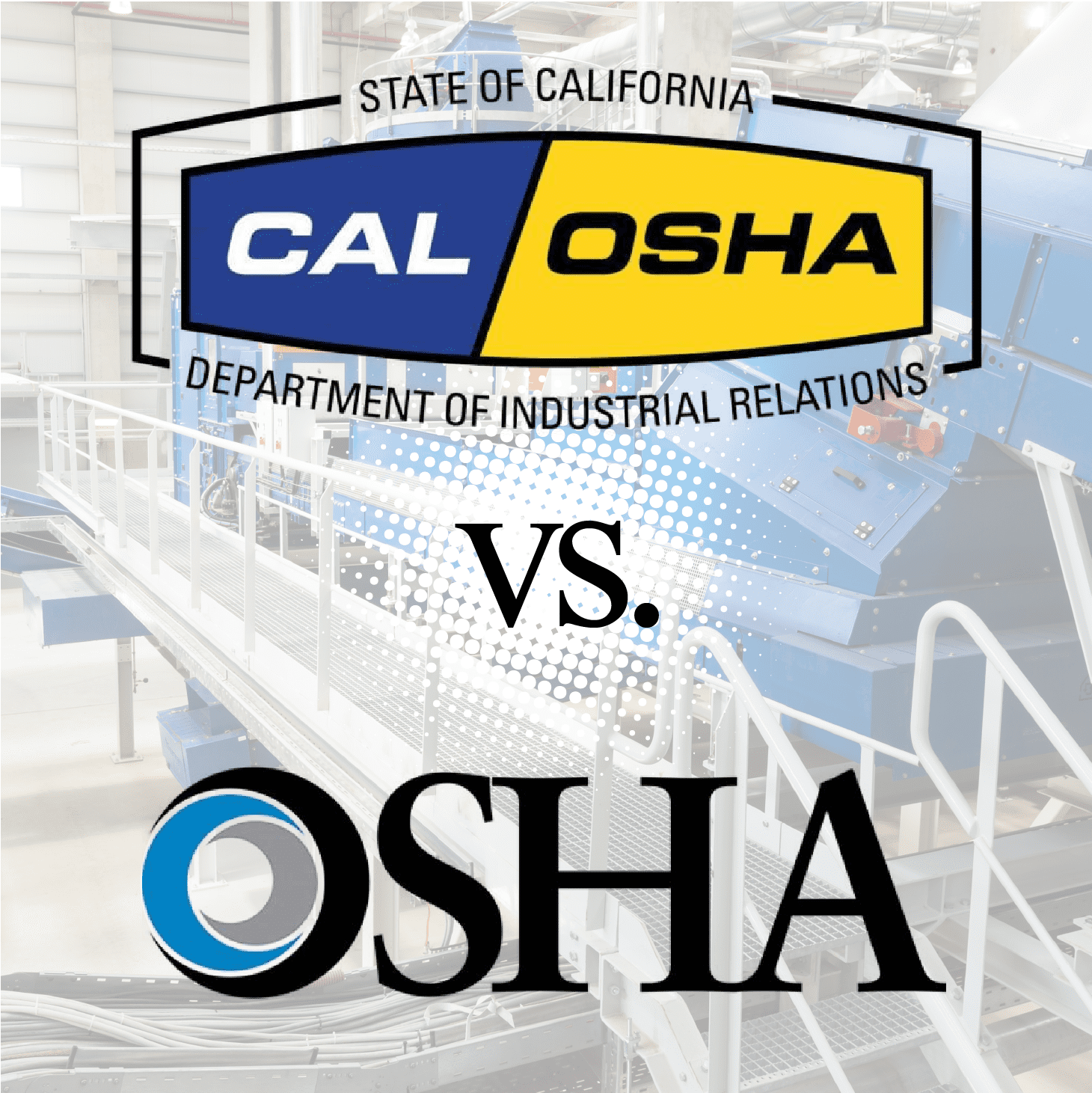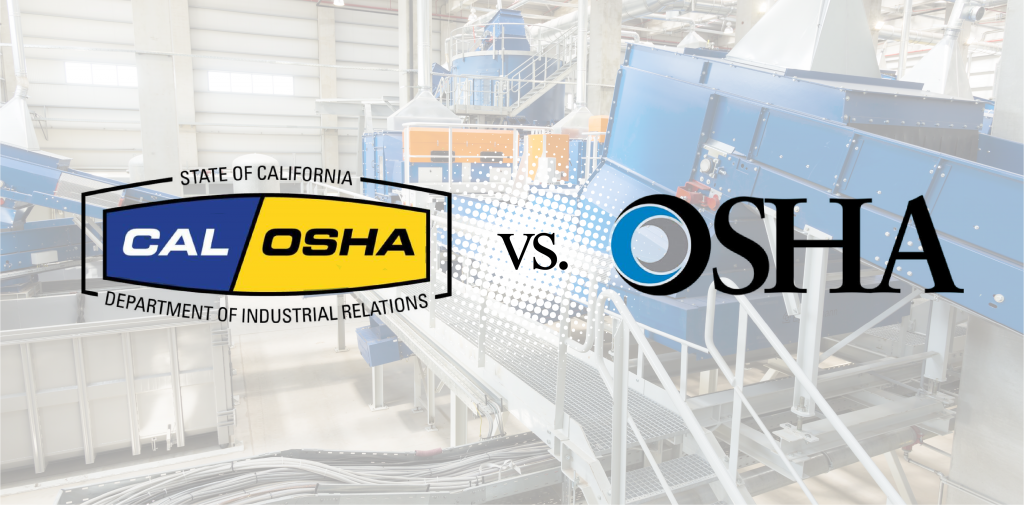
Cal/OSHA vs. Federal OSHA

Written by: Virginia McCormick, NES, Inc.

Cal/OSHA maintains a state health & safety plan that differs in some elements from the federal OSHA plan.
Cal/OSHA vs. Federal OSHA: An Overview
Since its establishment in late 1970, federal OSHA has maintained authority over assuring worker health & safety in the United States through a variety of training, education, and outreach programs. As a part of the United States Department of Labor, federal OSHA also oversees and approves workplace health & safety programs operated by individual states or U.S. territories.
State health & safety plans and federal OSHA plans are often very similar in content. In fact, a state plan must address everything in the federal OSHA plan at a minimum for it to be considered for approval. According to the federal OSHA website, “state plans are monitored by OSHA and must be at least as effective as OSHA in protecting workers and in preventing work-related injuries, illnesses and deaths.”
California’s state health & safety plan was approved by OSHA in 1973 and is one of 22 state plans covering both private sector and government workers. Since then, the plan has been enforced through Cal/OSHA. The state agency has been developing standards and practices for California that may not be covered as extensively as federal OSHA. In some cases, Cal/OSHA policies have even been implemented in areas where there are no federal OSHA counterparts.
Because California employers must adhere to both federal OSHA and Cal/OSHA workplace health & safety regulations, it is important to recognize the differences between the two. Just like many state plans, these differences are entirely found within the Cal/OSHA plan.

When it comes to regulations, understanding the Cal/OSHA vs. federal OSHA differences can feel like a game, but there are real consequences to consider.
Cal/OSHA vs. Federal OSHA: Protection Levels
Much of the following information is referenced in the California Department of Industrial Relations (DIR) Comparison of Cal/OSHA and Federal OSHA programs fact sheet. Cal/OSHA is a division of DIR, and the provided fact sheet summarizes the differences between California’s state plan and the federal OSHA plan.
PEL & Non-PEL Standards
Federal OSHA still uses many of the original permissible exposure limits (PELs) from 1970. In contrast, DIR emphasizes that Cal/OSHA has been regularly updating PELs since the state agency was established. According to the fact sheet, Cal/OSHA has either added to or revised its PELs more than 20 times. Cal/OSHA also has PELs for chemicals that federal OSHA does not currently regulate, such as gasoline, potassium, welding fumes, and wood dust.
Some examples of differing PELs between the state and federal agencies are shown in the following table:

Cal/OSHA has also set non-PEL standards and programs that are considered by many to be more protective than their federal OSHA counterparts, including ventilation requirements for laboratory-type hood operations and washing facilities at construction jobsites and amendments to bloodborne pathogens and hazard communication programs.
Process Safety Management
Cal/OSHA’s Process Safety Management (PSM) Unit is, “responsible for inspecting refineries and chemical plants that handle large quantities of toxic and flammable materials.” According to DIR, Cal/OSHA makes regular visits to facilities in order to conduct program quality reviews, respond to complaints, perform fatality investigations, evaluate chemical releases and fires, and investigate explosions.
This is compared to federal OSHA’s National Emphasis Program, which DIR asserts, “only provides a ‘snapshot’ of operations at the time of inspection.” The idea behind Cal/OSHA’s PSM Unit is that conducting inspections more regularly than the federal OSHA counterpart will result in more effective regulation of high-hazard workplace environments.
Mining & Tunneling
Both federal OSHA, under the Mine Safety and Health Administration (MSHA), and Cal/OSHA cover mining and milling operations. However, unlike federal OSHA, Cal/OSHA also holds regulatory authority over finishing operations. Additionally, Cal/OSHA requires all tunnel construction jobs to have a state-certified safety representative and gas tester on-site and to conduct compliance inspections every two months while the tunnel is under construction.

High-rise window cleaning hazards become more concerning as California cities expand; these standards notably differ in Cal/OSHA vs. federal OSHA regulations.
Unique Cal/OSHA Programs: State Coverage with No Federal Counterpart
Since 1973, Cal/OSHA has been issuing standards that are considered more stringent than federal OSHA’s baseline. In some cases, a state program will include statutes regarding specific hazards that federal OSHA does not address at all. The following Cal/OSHA coverage topics have no federal OSHA counterpart.
Diacetyl
Diacetyl is a naturally occurring byproduct of fermentation and is commonly used as a food flavoring in microwave popcorn and other food products. In 2010, Cal/OSHA adopted a standard that regulates employee exposure to the food flavoring. Acute exposure has been found to lead to pulmonary problems such as bronchiolitis obliterans, a serious and irreversible disease of the lungs that can cause impairment or death.
Under the regulation, California companies that use diacetyl or diacetyl-containing flavorings must have a medical surveillance program to monitor their employees’ health and lung function. In addition, they are recommended to take preventive measures to reduce exposure to diacetyl and other flavoring chemicals.
Diacetyl exposure has also recently become a concern in coffee processing operations. For more information on the 2017 Centers for Disease Control and Prevention (CDC) and National Institute for Occupational Safety and Health (NIOSH) findings on diacetyl exposure in coffee processing, see the NES article, Diacetyl Exposure in Coffee Processing Operations.
High-Rise Window Cleaning
According to the DIR fact sheet, Cal/OSHA has one of only two unique health & safety programs in the United States that addresses high-rise window cleaning hazards. The state standard requires annual inspections of window cleaning equipment and for those inspections to be performed by a third-party inspector.
Injury & Illness Prevention Program and Ergonomics
The California Injury & Illness Prevention Program (IIPP) was adopted in 1991 and requires all employers in the state to have a safety & health program tailored specifically to their workplace. This written program must identify the person responsible for its implementation and include both a system that ensures employees comply with safe work practices and protocols for effectively communicating those practices.
Also adopted in the 1990s, the Repetitive Motion Injury (RMI) standard applies to any job or process in which an RMI has occurred. The standard requires a program be designed to minimize the occurrence of RMIs and for that program to be properly implemented and understood by all employees.

The California high-heat standard exemplifies another big difference in Cal/OSHA vs. federal OSHA regulations.
Heat Illness Prevention Program
As a majority-Mediterranean climate, California is regularly subjected to high temperatures, especially in the state’s central valleys. Originally developed as an emergency standard in 2006, the Heat Illness Prevention Program was enacted to protect outdoor workers from the hazards of working in high-heat environments.
Under the Cal/OSHA program, employers must, “develop, put in writing, and implement effective procedures for complying” with the requirements of the Heat Illness Prevention Program. This includes providing access to water and shade, high-heat measures, emergency response procedures, and acclimatization methods for employees. According to DIR, the program has resulted in, “thousands of inspections, training programs, and outreach sessions” aimed to raise high-heat awareness in both employers and workers.
Aerosol Transmissible Diseases
In 2009, California adopted a standard to safeguard workers from the spread of airborne diseases. According to the DIR, the standard was enacted to, “protect workers in healthcare and related industries from the spread of diseases such as tuberculosis, measles, influenza and other pathogens by coughing and sneezing.”
Additional Public Safety Regulations Under Cal/OSHA
Cal/OSHA has specific regulations regarding public safety permit requirements and certifications that are not covered under federal OSHA. Elevators, pressure vessels, portable amusement and bungee jumping rides, and aerial passenger tramways such as ski lifts are all required to have specific permits and certifications under Cal/OSHA.
Cal/OSHA vs. Federal OSHA: The Bottom Line
Anyone living in one of the 22 states or territories with an OSHA-approved state plan must comply with state-level standards in addition to federal standards. This includes employers and their workers within California, who must comply with the Cal/OSHA standards. While an understanding of federal OSHA regulations is a good place to start, Cal/OSHA differences should also be considered and understood.
Proper compliance with both Cal/OSHA and federal OSHA safety standards will always help reduce the risk of fatalities, injuries, and hazards at worksites, which will in turn reduce the risk to employers of incurring serious citations from either agency.
Employers must be informed of all required safety measures and dispense this information to employees through regular training conducted by qualified training providers. By being serious and proactive about implementing safety management processes that engage employees, employers are making important efforts to keep their workers safe.
NES can help your business or agency stay compliant with both Cal/OSHA and federal OSHA regulations by providing top-quality training and consulting. For more information about our environmental health & safety training and consulting capabilities, contact NES at 916-353-2360 / 1-800-NES-ADVISE (1-800-637-2384) or office@nesglobal.net.
References:
California Department of Industrial Relations: Cal/OSHA Homepage
United State Department of Labor: OSHA Homepage
Cal/OSHA vs Federal OSHA: PELs
California Department of Public Health: Flavoring-Related Lung Disease (Bronchiolitis Obliterans)
Cal/OSHA: Process Safety Management (PSM) Unit
Western Regional Climate Center: Climate of California
